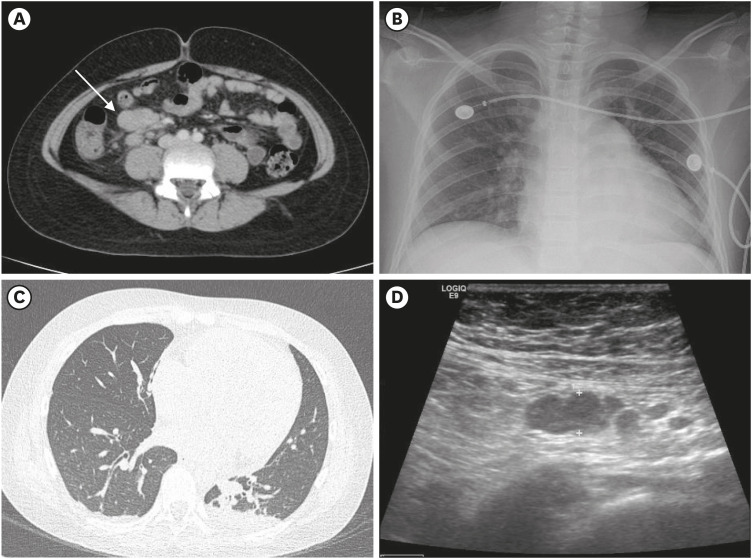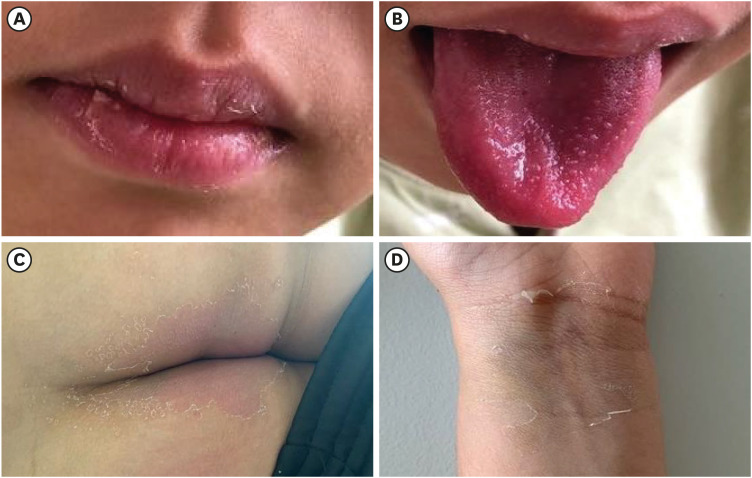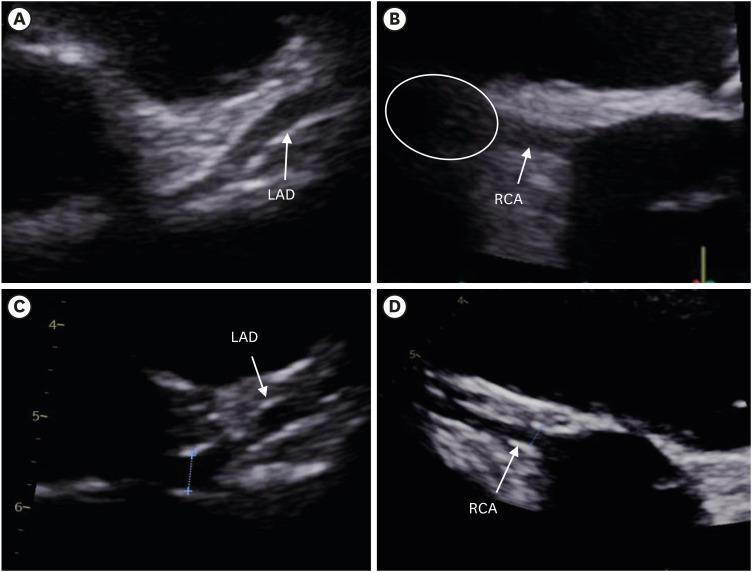J Korean Med Sci.
2020 Nov;35(43):e391. 10.3346/jkms.2020.35.e391.
Multisystem Inflammatory Syndrome in Children Related to COVID-19: the First Case in Korea
- Affiliations
-
- 1Department of Pediatrics, Kangbuk Samsung Hospital, Sungkyunkwan University School of Medicine, Seoul, Korea
- 2Division of Infectious Diseases, Department of Medicine, Samsung Medical Center, Sungkyunkwan University School of Medicine, Seoul, Korea
- KMID: 2508504
- DOI: http://doi.org/10.3346/jkms.2020.35.e391
Abstract
- Since mid-April 2020, cases of multisystem inflammatory syndrome in children (MIS-C) associated with coronavirus disease 2019 that mimics Kawasaki disease (KD) have been reported in Europe and North America. However, no cases have been reported in Korea. We describe an 11-year old boy with fever, abdominal pain, and diarrhea who developed hypotension requiring inotropes in intensive care unit. His blood test revealed elevated inflammatory markers, thrombocytopenia, hypoalbuminemia, and coagulopathy. Afterward, he developed signs of KD such as conjunctival injection, strawberry tongue, cracked lip, and coronary artery dilatation, and parenchymal consolidation without respiratory symptoms. Microbiological tests were all negative including severe acute respiratory syndrome coronavirus 2 (SARS-CoV-2) reverse transcription polymerase chain reaction. However, serum immunoglobulin G against SARS-CoV-2 was positive in repeated tests using enzyme-linked immunosorbent assay and fluorescent immunoassay. He was recovered well after intravenous immunoglobulin administration and discharged without complication on hospital day 13. We report the first Korean child who met all the criteria of MIS-C with features of incomplete KD or KD shock syndrome.
Keyword
Figure
Cited by 2 articles
-
The Importance of Early Recognition, Timely Management, and the Role of Healthcare Providers in Multisystem Inflammatory Syndrome in Children
Ji-Hyuk Lee, Heon-Seok Han, Joon Kee Lee
J Korean Med Sci. 2020;36(2):e17. doi: 10.3346/jkms.2021.36.e17.The First Case of Multisystem Inflammatory Syndrome in Adult after COVID-19 in Korea
Hyemin Chung, Hyeonji Seo, Sunghee Park, Haein Kim, Jiwon Jung, Yong Pil Chong, Sung-Han Kim, Sang-Oh Lee, Sang-Ho Choi, Yang Soo Kim, Min Jae Kim
J Korean Med Sci. 2021;36(25):e181. doi: 10.3346/jkms.2021.36.e181.
Reference
-
1. World Health Organization. Coronavirus disease (COVID-19) pandemic. Updated 2020. Accessed May 12, 2020. https://www.who.int/emergencies/diseases/novel-coronavirus-2019.2. Lee J, Kim KH, Kang HM, Kim JH. Do we really need to isolate all children with COVID-19 in healthcare facilities? J Korean Med Sci. 2020; 35(29):e277. PMID: 32715674.
Article3. Toubiana J, Poirault C, Corsia A, Bajolle F, Fourgeaud J, Angoulvant F, et al. Kawasaki-like multisystem inflammatory syndrome in children during the covid-19 pandemic in Paris, France: prospective observational study. BMJ. 2020; 369:m2094. PMID: 32493739.
Article4. DeBiasi RL, Song X, Delaney M, Bell M, Smith K, Pershad J, et al. Severe coronavirus disease-2019 in children and young adults in the Washington, DC, metropolitan region. J Pediatr. 2020; 223:199–203.e1. PMID: 32405091.
Article5. Morand A, Urbina D, Fabre A. COVID-19 and Kawasaki like disease: the known-known, the unknown-known and the unknown-unknown. Preprints (Basel). 2020.
Article6. World Health Organization. Case report form for suspected cases of multisystem inflammatory syndrome (MIS) in children and adolescents temporally related to COVID-19. Updated 2020. Accessed July 1, 2020. https://www.who.int/publications/i/item/case-report-form-for-suspected-cases-of-multisystem-inflammatory-syndrome-(mis)-in-children-and-adolescents-temporally-related-to-covid-19.7. Dufort EM, Koumans EH, Chow EJ, Rosenthal EM, Muse A, Rowlands J, et al. Multisystem inflammatory syndrome in children in New York State. N Engl J Med. 2020; 383(4):347–358. PMID: 32598830.
Article8. Korea Disease Control and Prevention Agency. The update of COVID-19 in Korea as of Oct 5. Updated 2020. Accessed October 5, 2020. https://www.cdc.go.kr/board/board.es?mid=a20501000000&bid=0015.9. World Health Organization. COVID-19 in the Philippines situation report 01. Updated 2020. Accessed October 19, 2020. https://www.who.int/philippines/internal-publications-detail/covid-19-in-the-philippines-situation-report-01.10. Verdoni L, Mazza A, Gervasoni A, Martelli L, Ruggeri M, Ciuffreda M, et al. An outbreak of severe Kawasaki-like disease at the Italian epicentre of the SARS-CoV-2 epidemic: an observational cohort study. Lancet. 2020; 395(10239):1771–1778. PMID: 32410760.
Article11. Centers for Disease Control and Prevention. Multisystem inflammatory syndrome in children (MIS-C) associated with coronavirus disease 2019 (COVID-19). Updated 2020. Accessed July 1, 2020. https://emergency.cdc.gov/han/2020/han00432.asp.12. Chiotos K, Bassiri H, Behrens EM, Blatz AM, Chang J, Diorio C, et al. Multisystem inflammatory syndrome in children during the coronavirus 2019 pandemic: a case series. J Pediatric Infect Dis Soc. 2020; 9(3):393–398. PMID: 32463092.
Article13. Cheung EW, Zachariah P, Gorelik M, Boneparth A, Kernie SG, Orange JS, et al. Multisystem inflammatory syndrome related to COVID-19 in previously healthy children and adolescents in New York City. JAMA. 2020; 324(3):294–296. PMID: 32511676.
Article14. Sethuraman N, Jeremiah SS, Ryo A. Interpreting diagnostic tests for SARS-CoV-2. JAMA. 2020; 323(22):2249–2251. PMID: 32374370.
Article15. Feldstein LR, Rose EB, Horwitz SM, Collins JP, Newhams MM, Son MBF, et al. Multisystem inflammatory syndrome in U.S. children and adolescents. N Engl J Med. 2020; 383(4):334–346. PMID: 32598831.
Article16. Whittaker E, Bamford A, Kenny J, Kaforou M, Jones CE, Shah P, et al. Clinical characteristics of 58 children with a pediatric inflammatory multisystem syndrome temporally associated with SARS-CoV-2. JAMA. 2020; 324(3):259–269. PMID: 32511692.
Article17. Liu L, Wei Q, Lin Q, Fang J, Wang H, Kwok H, et al. Anti-spike IgG causes severe acute lung injury by skewing macrophage responses during acute SARS-CoV infection. JCI insight. 2019; 4(4):e123158.
Article
- Full Text Links
- Actions
-
Cited
- CITED
-
- Close
- Share
- Similar articles
-
- Multisystem Inflammatory Syndrome in Adults in an 80-Year-Old Korean Woman after COVID-19: A Case Report
- Frosted Branch Angiitis Associated with COVID-19-related Multisystem Inflammatory Syndrome in Children
- The Importance of Early Recognition, Timely Management, and the Role of Healthcare Providers in Multisystem Inflammatory Syndrome in Children
- Comparison of COVID-19-associated multisystem inflammatory syndrome in children (MIS-C) and Kawasaki disease shock syndrome: case reports and literature review
- The First Case of Multisystem Inflammatory Syndrome in Adult after COVID-19 in Korea




